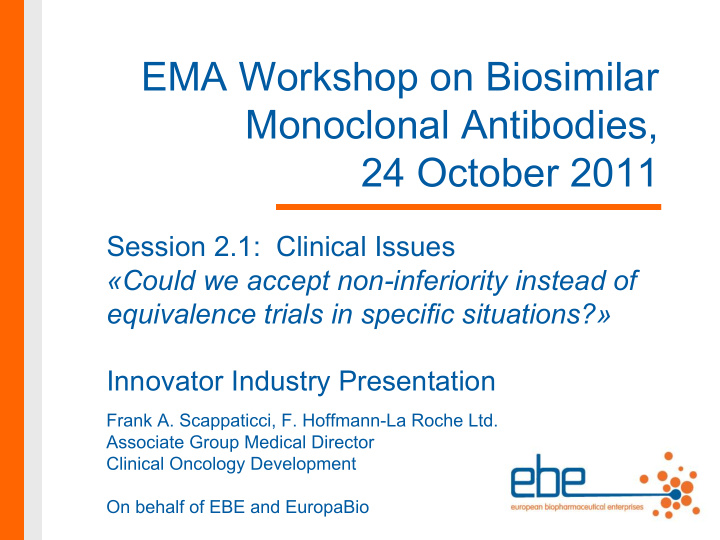



EMA Workshop on Biosimilar Monoclonal Antibodies, 24 October 2011 Session 2.1: Clinical Issues «Could we accept non-inferiority instead of equivalence trials in specific situations?» Innovator Industry Presentation Frank A. Scappaticci, F. Hoffmann-La Roche Ltd. Associate Group Medical Director Clinical Oncology Development On behalf of EBE and EuropaBio
Equivalence versus Non-inferiority Clinical Trial Design for Similarity • EBE agrees with the current position of the BMWP that equivalence trials are clearly preferred for the clinical comparison of a biosimilar and its reference product with regard to efficacy / safety • Non-inferiority studies can be done if appropriately justified The objective of an equivalence trial is to show that there are no clinically • important differences between control and study treatments The objective of a non-inferiority trial is to show that the study treatment is • not substantially worse than the control treatment – It does not rule out superiority over the reference product – Superiority in efficacy, for example, infers a different clinical effect that could also be associated with a different safety profile
Reasons Why Non-Inferiority is not the Preferred Study Design for Establishing Biosimilarity • Superior efficacy of the study treatment of the biosimilar infers a different clinical or physiological effect of the product - such a product may have a different safety profile • In some instances, superior efficacy could bring increased rates or severity of adverse events
Equivalence versus Non-inferiority Clinical Trial Design for Similarity A situation that may allow for a non-inferiority design: • Non-inferiority could be used if the target receptor is continuously saturated at the clinical dose and well known to be the MOA for the clinical effect • A hierarchical test should be considered to first test for non- inferiority and then superiority • If superiority is determined clinically, then the product should no longer be considered a biosimilar • Such a product must be evaluated as a new product and undergo the usual regulatory review for innovator products
Determination of Equivalence Trial Margins • By ICH E10 guidelines, this must be based on both clinical and statistical factors • The biosimilar company must justify the margins based on clinical setting and may vary depending on therapeutic area • Different statistical margins may be appropriate or required based on effect size and clinical setting (ex. in oncology: adjuvant breast cancer versus metastatic breast cancer)
Recommend
More recommend